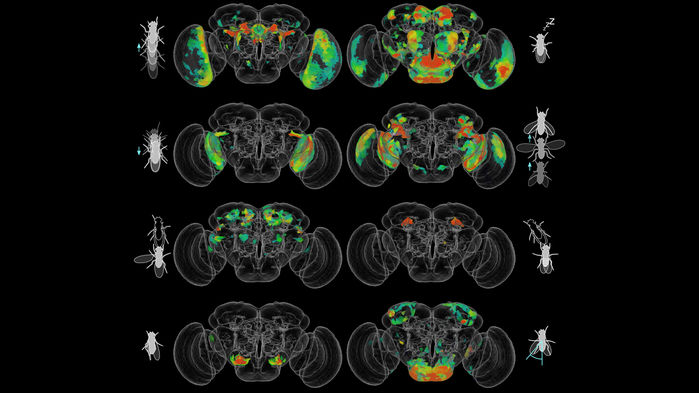Source – sciencemag.org
Can you imagine watching 20,000 videos, 16 minutes apiece, of fruit flies walking, grooming, and chasing mates? Fortunately, you don’t have to, because scientists have designed a computer program that can do it faster. Aided by artificial intelligence, researchers have made 100 billion annotations of behavior from 400,000 flies to create a collection of maps linking fly mannerisms to their corresponding brain regions.
Experts say the work is a significant step toward understanding how both simple and complex behaviors can be tied to specific circuits in the brain. “The scale of the study is unprecedented,” says Thomas Serre, a computer vision expert and computational neuroscientist at Brown University. “This is going to be a huge and valuable tool for the community,” adds Bing Zhang, a fly neurobiologist at the University of Missouri in Columbia. “I am sure that follow-up studies will show this is a gold mine.”
At a mere 100,000 neurons—compared with our 86 billion—the small size of the fly brain makes it a good place to pick apart the inner workings of neurobiology. Yet scientists are still far from being able to understand a fly’s every move.
To conduct the new research, computer scientist Kristin Branson of the Howard Hughes Medical Institute in Ashburn, Virginia, and colleagues acquired 2204 different genetically modified fruit fly strains (Drosophila melanogaster). Each enables the researchers to control different, but sometimes overlapping, subsets of the brain by simply raising the temperature to activate the neurons.
Then it was off to the Fly Bowl, a shallowly sloped, enclosed arena with a camera positioned directly overhead. The team placed groups of 10 male and 10 female flies inside at a time and captured 30,000 frames of video per 16-minute session. A computer program then tracked the coordinates and wing movements of each fly in the dish. The team did this about eight times for each of the strains, recording more than 20,000 videos. “That would be 225 straight days of flies walking around the dish if you watched them all,” Branson says.
Next, the team picked 14 easily recognizable behaviors to study, such as walking backward, touching, or attempting to mate with other flies. This required a researcher to manually label about 9000 frames of footage for each action, which was used to train a machine-learning computer program to recognize and label these behaviors on its own. Then the scientists derived 203 statistics describing the behaviors in the collected data, such as how often the flies walked and their average speed. Thanks to the computer vision, they detected differences between the strains too subtle for the human eye to accurately describe, such as when the flies increased their walking pace by a mere 5% or less.
“When we started this study we had no idea how often we would see behavioral differences,” between the different fly strains, Branson says. Yet it turns out that almost every strain—98% in all—had a significant difference in at least one of the behavior statistics measured. And there were plenty of oddballs: Some superjumpy flies hopped 100 times more often than normal; some males chased other flies 20 times more often than others; and some flies practically never stopped moving, whereas a few couch potatoes barely budged.
Then came the mapping. The scientists divided the fly brain into a novel set of 7065 tiny regions and linked them to the behaviors they had observed. The end product, called the Browsable Atlas of Behavior-Anatomy Maps, shows that some common behaviors, such as walking, are broadly correlated with neural circuits all over the brain, the team reports today in Cell. On the other hand, behaviors that are observed much less frequently, such as female flies chasing males, can be pinpointed to tiny regions of the brain, although this study didn’t prove that any of these regions were absolutely necessary for those behaviors. “We also learned that you can upload an unlimited number of videos on YouTube,” Branson says, noting that clips of all 20,000 videos are available online.
Branson hopes the resource will serve as a launching pad for other neurobiologists seeking to manipulate part of the brain or study a specific behavior. For instance, not much is known about female aggression in fruit flies, and the new maps gives leads for which brain regions might be driving these actions.
Because the genetically modified strains are specific to flies, Serre doesn’t think the results will be immediately applicable to other species, such as mice, but he still views this as a watershed moment for getting researchers excited about using computer vision in neuroscience. “I am usually more tempered in my public comments, but here I was very impressed,” he says.
